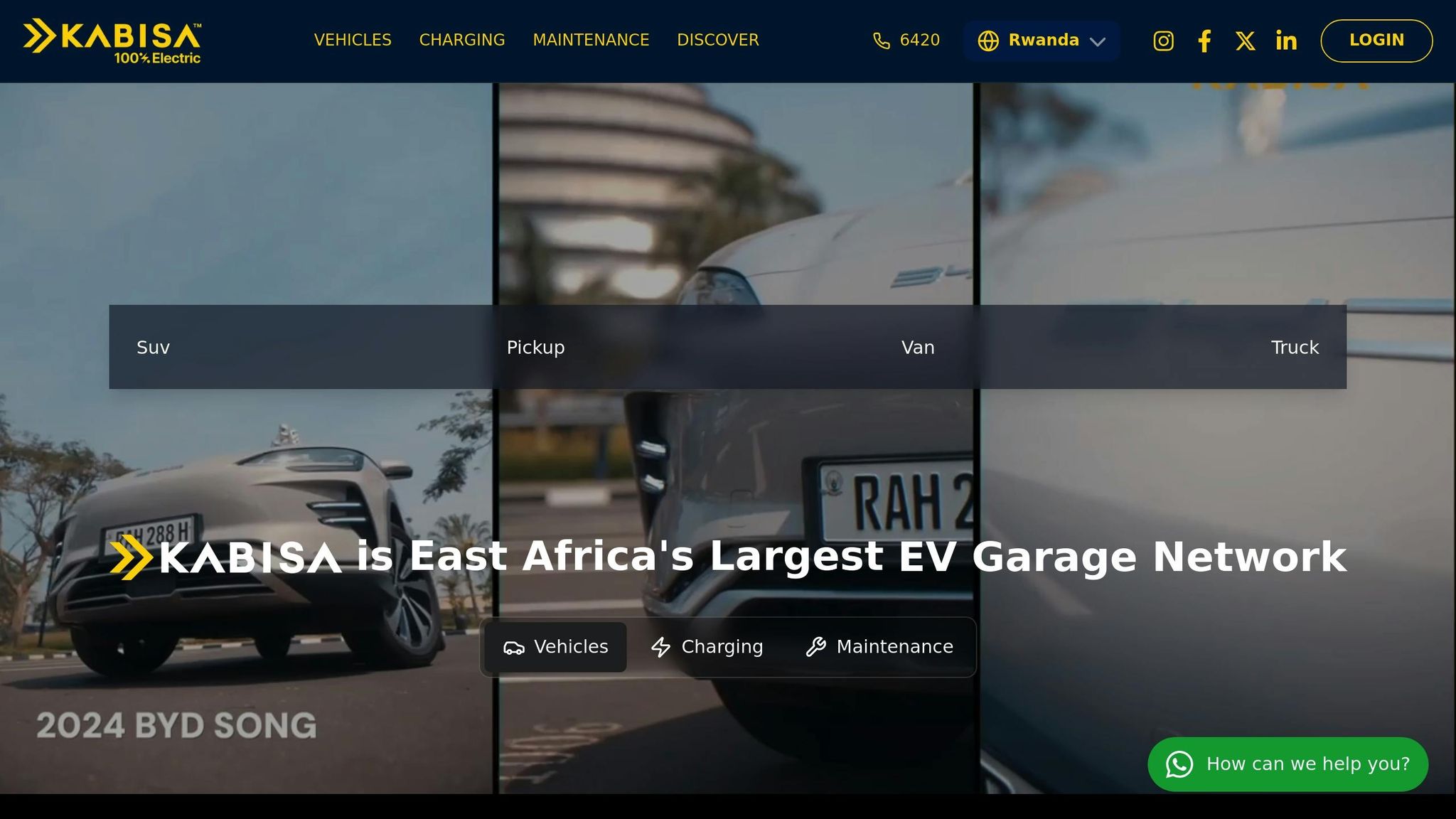Rwanda is making bold moves toward cleaner transportation. The government is upgrading roads, expanding EV charging networks, and introducing tax reforms to promote electric vehicles (EVs). Recent developments include:
- EV tax reforms (effective July 1, 2025) to encourage EV adoption.
- Expanded charging networks in Kigali and nearby areas as of August 2025.
- Traffic regulation updates to reduce congestion and enforce stricter emissions standards.
These efforts aim to replace older road systems designed for internal combustion engine (ICE) vehicles, which contribute to pollution and inefficiency. The shift to EV-compatible roads is reducing emissions, improving traffic flow with digital tools, and offering better user experiences for EV drivers. Rwanda is setting an example for clean mobility in developing nations.
The Best EV Experience Centre In Africa | KABISA EV House

1. Traditional ICE Road Networks
Rwanda’s older road systems were designed primarily for internal combustion engine (ICE) vehicles, with little consideration for modern efficiency or environmental concerns.
Emissions
ICE vehicles release pollutants into the air, and these traditional road networks lack mechanisms to address or reduce these emissions. While it’s well-known that emissions from ICE vehicles can negatively affect urban air quality, detailed studies on the specific emission patterns along these roadways remain sparse.
Urban Mobility Efficiency
Traffic management on these roads relied heavily on static tools like signs and traffic lights. Unlike the digital systems now integrated into electric vehicle (EV) infrastructure, these older methods fall short in optimizing traffic flow, particularly in busy urban areas.
User Experience
Drivers using ICE road networks often had to plan their routes around frequent stops for refueling and maintenance. Additionally, they contended with issues like engine noise and vibrations – challenges largely absent in modern EV systems. While much of the focus today is on the growing EV market, less attention is given to the everyday experiences of drivers navigating these older road systems. These legacy networks now stand in stark contrast to the more advanced EV-compatible infrastructure that has started to emerge.
2. Upgraded EV-Compatible Roads
Rwanda is stepping up its efforts to support the growing electric vehicle (EV) market by upgrading its roads and expanding charging networks, particularly in Kigali.
Emissions
The push for EV-compatible roads aligns with Rwanda’s environmental goals, aiming to lower air pollution by encouraging the use of zero-emission vehicles. While specific emissions data hasn’t been released, the initiative reflects the country’s commitment to cleaner air.
Urban Mobility Efficiency
The upgraded roads now incorporate digital tools that make urban travel more seamless. These tools provide real-time updates on charging station locations and road conditions, making city navigation easier for EV drivers.
Infrastructure Costs
Although exact investment figures haven’t been shared, the focus on sustainability is evident. These upgrades not only promote eco-friendly transportation but also improve convenience and accessibility for drivers.
User Experience
As infrastructure improvements continue, EV drivers in Rwanda can look forward to better access to charging stations and enhanced support services. According to AutoMag.RW, platforms like AUTO24.rw are playing a key role in this transition by offering a variety of EV models, including Tesla, Leapmotor, and ROX.
sbb-itb-7bc66b5
Pros and Cons
Rwanda’s shift toward EV-compatible roads brings clear environmental benefits compared to traditional roads designed for internal combustion engine (ICE) vehicles.
| Aspect | EV-Compatible Roads | Traditional ICE Roads |
|---|---|---|
| Emissions | Produce zero tailpipe emissions; renewable energy initiatives help lower overall emissions from production to operation. | Support vehicles that release CO2, NOx, and particulate matter, negatively impacting air quality in cities. |
This comparison underscores the tangible environmental improvements tied to Rwanda’s infrastructure updates. By meeting 2025 emissions standards and expanding EV charging networks, Rwanda demonstrates its dedication to cleaner, more sustainable urban transportation.
Conclusion
Rwanda’s approach to electric vehicles (EVs) is shaping up to be a benchmark for sustainable urban mobility. With strategic policies and infrastructure upgrades, the country is paving the way for a cleaner, greener future. The upcoming EV tax reforms, set to take effect on July 1, 2025, are expected to further accelerate this transformation.
One of the most visible impacts is the reduction of emissions. EV-compatible roads are enabling the use of zero-emission vehicles, in stark contrast to the ongoing pollution from traditional internal combustion engine (ICE) vehicles. To overcome adoption hurdles, Kigali and other regions are expanding their EV charging networks, ensuring the infrastructure keeps pace with the growing demand from the automotive sector.
The automotive market in Rwanda is also evolving. Platforms like AUTO24.rw now feature a variety of EV options, including models like the ROX 01, Hongqi E-QM5, GAC Aion Y Plus, BYD vehicles, and the Tesla Model Y. In addition, initiatives like EV battery swaps highlight the market’s adaptability and readiness for change.
While challenges remain – such as scaling up EV roads and charging stations – the regulatory groundwork and infrastructure investments suggest Rwanda is well-positioned to continue its progress in expanding EV adoption.
FAQs
What steps is Rwanda taking to expand its electric vehicle infrastructure?
Rwanda is making significant strides in building its electric vehicle (EV) infrastructure, demonstrating its dedication to reducing carbon emissions and promoting greener transportation. A major focus has been on installing EV charging stations in cities and along key highways, making EV ownership more practical and accessible.
To further encourage adoption, the government has introduced tax breaks on EV imports and essential components, lowering the cost barrier for potential buyers. Collaborations with private companies are also playing a crucial role, shaping policies and accelerating the development of EV-friendly infrastructure.
These initiatives not only aim to enhance urban transportation and cut fossil fuel use but also solidify Rwanda’s position as a frontrunner in sustainable mobility across Africa.
What are the key goals of Rwanda’s new EV tax reforms set to take effect in 2025, and how will they promote electric vehicle adoption?
The upcoming EV tax reforms, set for 2025, aim to make electric vehicles (EVs) more affordable and accessible in Rwanda. Although the full details of these reforms haven’t been disclosed yet, they are expected to include measures like lowering import taxes, providing tax breaks, or waiving certain fees for EVs and their supporting infrastructure, such as charging stations.
These efforts are part of Rwanda’s larger vision to improve urban mobility, cut down on carbon emissions, and promote environmentally friendly practices. By boosting EV adoption, Rwanda also seeks to grow its automotive industry and establish itself as a regional leader in sustainable transportation.
What obstacles is Rwanda encountering in expanding EV-friendly roads and charging stations, and how are these being tackled?
Rwanda is steadily advancing in creating infrastructure to support electric vehicles (EVs), but it’s not without its hurdles. Some of the key challenges include the steep upfront costs of constructing charging stations, inconsistent access to dependable electricity in certain regions, and a general lack of public awareness about EVs. On top of that, upgrading current road systems to accommodate EVs demands significant investment and meticulous planning.
To tackle these obstacles, the government has teamed up with private investors to fund the development of charging networks and enhance the reliability of the electrical grid. Policies encouraging the use of renewable energy and providing subsidies for EV infrastructure are also playing a crucial role in speeding up progress. These initiatives align with Rwanda’s larger goals of improving urban mobility and cutting carbon emissions, laying the groundwork for a more sustainable future.
Related Blog Posts
- How Rwanda’s Hills Affect EV Range
- Rwanda’s ICE Vehicles: Carbon Emissions Impact
- Rwanda’s Plan for 20% Electric Buses by 2030
- Is Rwanda Ready for Electric Vehicles?





